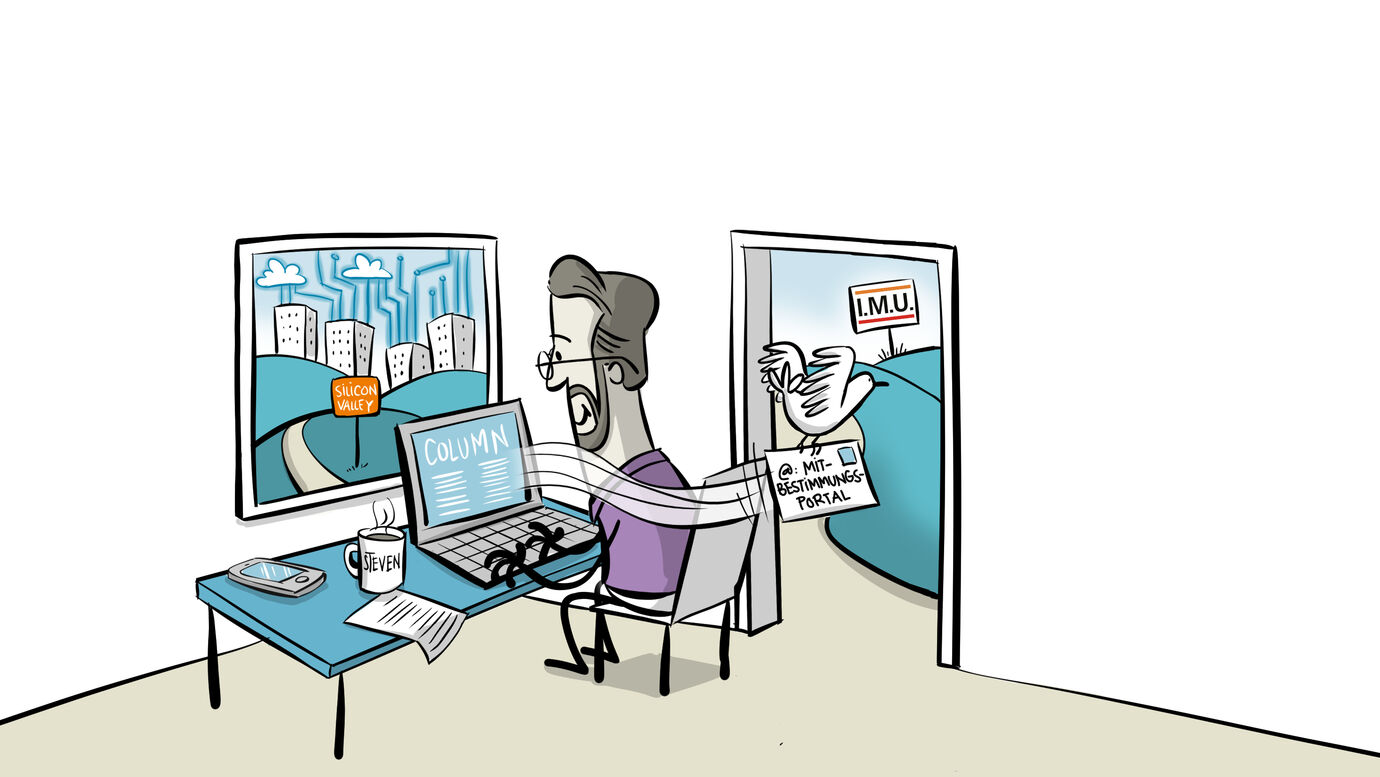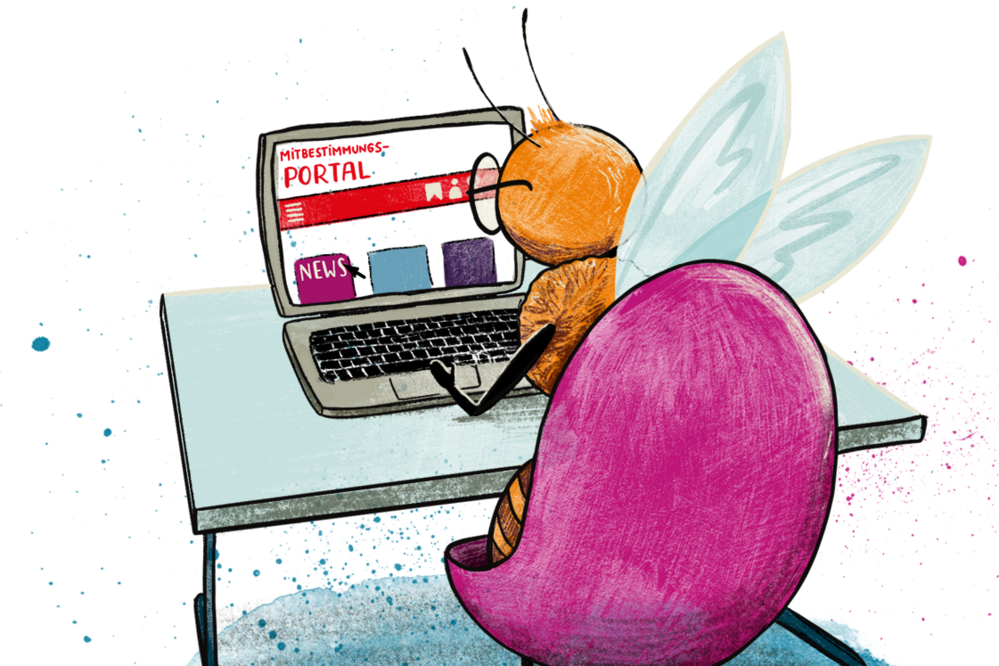Column
AI's impact on US workplaces continues to accelerate
AI impact is accelerating as Donald Trump goes from being a critic to a big investor in AI (and also cryptocurrency).

The slow creep of artificial intelligence into every crack and seam of society has been continuing over the last two years. That includes in the workplace. In November 2023, I wrote an article for Mitbestimmungsportal titled “US labor unions strike over impacts of AI and new technologies”, which reported on how a number of US labor unions, including the United Auto Workers, Screen Actors Guild and others were starting to fight back against new AI technologies that were threatening to upend their industries and kill their jobs.
Two years later, the intrusive march of AI has continued relentlessly. And now it is being aided, in part, by President Donald Trump, who initially was skeptical of AI (and crypto-currency) but now has become a big booster of both (more about the reasons why later). If 2023 was about experimenting with AI coming out of a pandemic, which launched widespread remote and stay-at-home work, and 2024 was about increasing adoption of AI, experts are saying 2025 will be the year when companies make way for deeper changes in the workplace based on ever more disruptive AI.
Fast growth of AI in the workplace
A recent quarterly workforce poll of nearly 20,000 workers, by the prominent pollster Gallup, found that the percentage of US employees who say they have used AI in their jobs at least a few times a year has nearly doubled, from 21% to 40%, since its 2023 poll. The percentage of US employees frequently using AI in their jobs also has nearly doubled to 19%, and daily AI use also has doubled to 8%.
This AI surge is particularly noticeable in white-collar jobs, with over a quarter of these employees reporting frequent AI use, also doubling since 2024. The industries with the highest percentages of frequent AI users include, not surprisingly, technology (50%), professional services (34%) and finance (32%). In comparison, frequent AI use by production and front-line workers has remained essentially flat for the past two years.
300 million jobs around the world could be lost to AI automation over the next 10 years, affecting 25% of the global labor market.
How fast will AI continue to spread? Many projections from a range of sources – including from self-interested Silicon Valley stakeholders – make this difficult to predict. Goldman Sachs, one of the world’s largest investment banks, has projected that 300 million jobs around the world could be lost to AI automation over the next 10 years, affecting 25% of the global labor market. The World Economic Forum, which is pro-AI growth and investment, says that in five years the proportion of work tasks performed mainly by AI machines will grow from just over one-fifth to more than one-third. The widely discussed Scenario AI 2027 report quotes experts expecting quick implementation over the next decade, and an impact „exceeding that of the Industrial Revolution.“
Does AI increase labor productivity? Many workers say “no!”
The reasons for implementing AI throughout the workplace is to try and increase productivity. But productivity is notoriously difficult to measure or to tease out cause from effect, and so far the results in the data are mixed. But workers themselves are indicating that AI is making more work for them, not less, and causing burnout.
A recent study from CSIRO, one of the main government research centers in Australia, examined the daily use of Microsoft 365 Copilot by 300 employees. While the majority self-reported productivity benefits, a sizeable minority (30%) did not. AI has increased productivity especially on “low-skill” tasks such as taking meeting notes and customer service, or work done by lower-skilled junior workers or workers who have poor language skills. A study in 2023 with 750 consultants from Boston Consulting Group found tasks were completed 18% faster with generative AI. A 2024 summary paper cites studies showing increases in organizational productivity from AI in Germany, Italy and Taiwan.
However another analysis of 300,000 US firms didn’t find a significant correlation between AI adoption and productivity, even though it did find such a correlation for other technologies, such as robotics and cloud computing. But other studies have uncovered some concerning results, based on workers’ self-reports.
Forty percent of employees feel their company is asking too much of them when it comes to AI, contributing to their burnout.
One survey from the online labor platform Upwork polled 2,500 professionals, finding that 77% of workers say that generative AI actually has decreased their productivity and increased their workloads. According to the report, many workers feel „overwhelmed by the added workload and complexity it brings,“ even as 71% of full-time employees report being burned out and 65% report struggling with employer demands on their productivity.
Some 47% of the workers polled said they are not trained to know how to unlock the productivity benefits, and they are not provided clear guidelines and communication about proper use. Survey respondents reported that they are spending more time reviewing or moderating AI-generated content (39%), invest more time learning to use the AI tools (23%), and are now being asked to do more work (21%). Consequently, among those who report using AI, only 16% strongly agree that the AI tools provided by their organization are useful for their work. Forty percent of employees feel their company is asking too much of them when it comes to AI, contributing to their burnout.
Meanwhile, US workers themselves are trying to figure out what AI means for their employment futures. According to a poll by Pew Research, half of workers (52%) say they are worried about the potential impact of AI use in the workplace, and 32% think it will lead to fewer job opportunities for them. Only 6% of workers believe using AI in the workplace will lead to more job opportunities for them. Workers with lower and middle incomes are more likely than those with upper incomes to say workplace AI use will lead to fewer job opportunities.
Their suspicions are not unfounded. Mark Benioff, CEO of Salesforce, one of the largest software companies in the world for business applications designed to increase productivity, says that AI already is doing 30% to 50% of all the work at his company, and he believes that growth will continue. Recently Microsoft announced two rounds of layoffs affecting 16,000 workers, reportedly driven in part by AI efficiencies. Meta/Facebook and Amazon have warned that AI will result in reductions in its own employee headcount, though some labor experts wonder if Mark Zuckerberg and Amazon are using the rise of AI as an excuse to enact the layoffs they already were planning.
And most recently, as if on cue, a new paper, from Stanford University’s Erik Brynjolfsson found that young workers aged 22–25 in “highly AI-exposed” jobs, such as software developers and customer service agents, experienced a 13 percent decline in employment since the advent of ChatGPT. This study confirms what others, such as the New York Federal Reserve, have found, namely that work opportunities for recent college graduates have “deteriorated noticeably,” which might well indicate an AI disruption in process.
Workplace problems from AI: privacy breaches, Big Brother and discrimination
AI already was causing problems for workers, and with its presence increasing in the workplace, the challenges are multiplying. Some of them are caused by adopting AI too quickly without established strategies or internal rules. That has resulted in data breaches and security risks associated with data handling. The collection and usage of vast amounts of employee data by AI raises the prospect for disturbing worker surveillance abuses.
Many increasingly face the daunting prospect of the „total control” panopticon workplace.
Already we have seen the growing use of AI in the workplaces, from individual spying technologies to robot time clocks that undercount workers’ hours. The notorious case of Amazon’s surveillance of employees and their AI-driven second-by-second productivity score is well documented. But less known are occupations like Kroger cashiers, UPS drivers and many others who increasingly face the daunting prospect of the „total control” panopticon workplace. AI apps and bots inform your boss if there are any „problems“ as they collect huge stockpiles of data to judge performance. The worker may not know what data the employer is collecting, but as these worker surveillance technologies develop it threatens to unleash a climate of fear that workers are being continually observed, and that they do not know the criteria for being considered a “good” or successful worker.
Beyond these Orwellian fears, AI systems are vulnerable to cyberattacks, potentially exposing sensitive information to illegal exploitation. And ethical concerns are rising over copyright infringement and legal liabilities because of how AI wantonly steals information from any sources on the Internet.
Recent alarming actions from the Trump administration
The current AI surge is being aided by the White House. For years, Donald Trump and his sons, Don Jr and Eric, showed no interest and were even dismissive and critical of AI as well as cryptocurrencies. But in Trump’s mercurial world his opinions can change unexpectedly, and suddenly AI is looking like a good family business opportunity.
One of President Trump’s first actions in his second term was to repeal the Biden administration’s “Executive Order on Safe, Secure, and Trustworthy Development and Use of Artificial Intelligence.” Trump also ordered a review of another Biden presidential directive, known as a National Security Memo, governing national security use of AI. Days later, Trump issued his own AI executive order that directed federal agencies to “integrate modern technology” into hiring and other purposes. Many fear that order will result in unfair AI uses arising from bias in the use of algorithms. The inherent biases, which is based on the training data used that reflects societal prejudices, has already led to discriminatory outcomes in hiring, promotions and other workplace decisions, as well as who gets a loan, who goes to jail, and other sensitive decisions.
Recently the National Institute of Workers’ Rights wrote that, with AI’s advance, the Trump administration has launched an unprecedented attack on civil and labor rights enforcement, using AI as a way to weed out the people they don’t want to hire. With an estimated 98.4% of Fortune 500 companies using AI in the hiring process, the potential scale of AI discrimination is enormous.
CBS reports that the Trump family's net worth has increased by $2.9 billion thanks to its various investments.
So why the sudden interest and focus by Trump and his sons on AI? Besides wanting to wield it for partisan political advantage, the Trump family has discovered that “there is gold in them thar hills.” They have figured out how to make a lot of money -- billions of dollars -- with AI investments, and cryptocurrencies too. According to Forbes, the Trump family’s investment in AI infrastructure and crypto signifies a broader shift in the family business strategy, moving beyond traditional ventures like real estate and hotels to embrace these new technology areas.
A mere weeks after Trump loosened the Biden administration’s regulations, Don Jr. and Eric Trump invested in a new company, American Data Centers Inc., which aims to build high-performance computing infrastructure to support AI, cloud computing, and cryptocurrency mining. This investment positions the Trump family to profit from government-backed growth for targeted AI companies, including data center expansion. CBS reports that the Trump family's net worth has increased by $2.9 billion thanks to its various investments, which now reportedly represent nearly 40% of Trump’s personal net worth.
Led initially by Tesla CEO Elon Musk’s DOGE, the Silicon Valley mindset of “move fast and break things” and “do it now and apologize later” has taken over the White House. Trump is overturning 50 years of Republican orthodoxy with recent actions such as the White House demanding a 10-15% equity stake from AI infrastructure companies like Intel and NVIDIA as the price for receiving government investment subsidies from, ironically, the Biden administration’s CHIPS Act (which Trump previously had criticized). In effect partially nationalizing the economy, Trump’s goal is clear: push the accelerator on anything that can augment breakneck AI development and deployment.
No one expects any significant regulation of these industries by the Trump administration.
Businesses that align with White House policy, like those backed by Trump's sons, will benefit from favoritism in procuring future government contracts related to AI and data centers development. At the same time, Trump has removed AI protections and exposed workers and everyday people to real-world harms.
The hands-off climate around AI, as well as crypto and Silicon Valley companies in general, and with the president and his family having such an enormous financial stake in AI’s widespread deployment, AI will continue to expand rapidly into the workplace. No one expects any significant regulation of these industries by the Trump administration.
At a time when the new rules for AI deployment in the workplace and the economy are being decided for the next 10-20 years, the laissez-faire regulators are stepping back even further. With less regulation and limits to protect workers and society as a whole, and an assertive president smashing the guardrails between the federal government and private enterprise, the United States finds itself in risky, uncharted waters.
German Language Version
-
Column
AI's impact on US workplaces continues to accelerate
-
Column
Trump and Musk mounting furious attack on labor rights and workers
-
Column
US support for codetermination from an unlikely source – conservative Republicans
-
Column
Can the EU and the US protect their 21st century workforces?
-
Column
Massive tech layoffs continue as companies retool for AI
-
Column
US labor unions strike over impacts of AI and new technologies
-
Column
Antitrust law is (finally) being enforced again in the U.S.
-
Column
Employer surveillance against workers spreads
-
Column
If it seems too good to be true … it probably is
-
Column
Helping gig workers help themselves
-
Column
Workers of the World…quit?
-
Column
Will US labor unions stand by Uber drivers and gig workers?
-
Column
Stirrings of union organizing in the “paradise” of Big Tech
-
Column
Will Pres. Joe Biden restore worker and union power?
-
Column
Corona-fied: employers spying on remote workers in their homes?
-
Column
The challenges of the post-coronavirus workforce
-
Column
Amazon workers fight back
-
Column
A blow against "bogus self-employment" and gig economy
-
Column
Renewing Worker Cooperatives for the Digital Age
-
Column
Codetermination takes the spotlight in the US
-
Column
Who will fight for the 'good jobs' economy?
-
Column
Trump attacks workers and the labor movement in the US
-
Column
The distributed workforce: what will jobs of the future look like?
-
Column
The "Uber way" of precarious work



